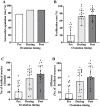Synchronization of the ovulation and copulation timings increased the number of in vivo fertilized oocytes in superovulated female mice
- PMID: 36745586
- PMCID: PMC9901804
- DOI: 10.1371/journal.pone.0281330
Synchronization of the ovulation and copulation timings increased the number of in vivo fertilized oocytes in superovulated female mice
Abstract
The number of sperm that reaches the oocytes in mammalian species is limited. In mice, 8-10 oocytes are ovulated, a similar number of sperm reaches the oocytes, and nearly all oocytes are fertilized via natural mating. Meanwhile, our improved superovulation technique (ultrasuperovulation: administration of inhibin antiserum and equine chorionic gonadotropin [IASe]) produced 100 oocytes from a single female C57BL/6 mouse but resulted in only approximately 20 fertilized oocytes via mating. We hypothesized that sperm shortage in the ampulla might cause this low fertilization rate. Mice were mated in the proestrus stage or after hormone injection, but ovulation timing was not considered. In clinical application, the rhythm method supports fertilization by testing the ovulation period and synchronizing the ovulation and copulation timings. Therefore, this study examined the effects of ovulation and copulation timings on in vivo fertilization in female mice with IASe. Synchronization of the ovulation and copulation timings increased fertilization efficiency in female mice with ultrasuperovulation. The number of embryos obtained post ovulation was three times higher than that obtained pre ovulation. This study suggests that synchronized ovulation and copulation timings improve the efficiency of in vivo fertilization in IASe-treated female mice. This technique can be used to produce genetically modified mice and develop technologies for infertility treatment.
Copyright: © 2023 Nakao et al. This is an open access article distributed under the terms of the Creative Commons Attribution License, which permits unrestricted use, distribution, and reproduction in any medium, provided the original author and source are credited.
Conflict of interest statement
The authors have declared that no competing interests exist.
Figures

Similar articles
-
Superovulation using the combined administration of inhibin antiserum and equine chorionic gonadotropin increases the number of ovulated oocytes in C57BL/6 female mice.PLoS One. 2015 May 29;10(5):e0128330. doi: 10.1371/journal.pone.0128330. eCollection 2015. PLoS One. 2015. PMID: 26024317 Free PMC article.
-
Induction of superovulation using inhibin antiserum and competence of embryo development in wild large Japanese field mice (Apodemus speciosus).Reprod Domest Anim. 2019 Dec;54(12):1637-1642. doi: 10.1111/rda.13573. Epub 2019 Oct 20. Reprod Domest Anim. 2019. PMID: 31587388
-
Immunotherapy using inhibin antiserum enhanced the efficacy of equine chorionic gonadotropin on superovulation in major inbred and outbred mice strains.Theriogenology. 2016 Sep 15;86(5):1341-6. doi: 10.1016/j.theriogenology.2016.04.076. Epub 2016 May 7. Theriogenology. 2016. PMID: 27242176
-
Enhancing Fertility in Mares: Recombinant Equine Gonadotropins.J Equine Vet Sci. 2019 May;76:6-13. doi: 10.1016/j.jevs.2019.03.004. Epub 2019 Mar 21. J Equine Vet Sci. 2019. PMID: 31084750 Review.
-
Reproduction of the female ferret (Mustela putorius furo).Reprod Domest Anim. 2008 Jul;43 Suppl 2:150-6. doi: 10.1111/j.1439-0531.2008.01155.x. Reprod Domest Anim. 2008. PMID: 18638117 Review.
Cited by
-
Rise and SINE: roles of transcription factors and retrotransposons in zygotic genome activation.Nat Rev Mol Cell Biol. 2025 Jan;26(1):68-79. doi: 10.1038/s41580-024-00772-6. Epub 2024 Oct 2. Nat Rev Mol Cell Biol. 2025. PMID: 39358607
-
A simple method for repeated in vivo sperm collection from laboratory mice.J Assist Reprod Genet. 2024 Sep;41(9):2537-2546. doi: 10.1007/s10815-024-03201-x. Epub 2024 Jul 17. J Assist Reprod Genet. 2024. PMID: 39017771 Free PMC article.
-
In vivo fertilization improved the cryotolerance and developmental ability of vitrified-warmed rat fertilized oocytes.Sci Rep. 2024 Oct 15;14(1):24198. doi: 10.1038/s41598-024-76073-x. Sci Rep. 2024. PMID: 39406819 Free PMC article.
References
Publication types
MeSH terms
LinkOut - more resources
Full Text Sources

